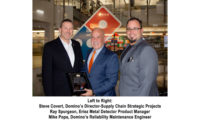A Mutually Beneficial Partnership
By Martin Schultz
Co-manufacturing has stayed with the times and become focused on service and quality.
Co-packing used to be where all that someone wanted was the lowest bidder,” says Mike DeSmet, vice president of food safety and quality assurance at Iowa-based West Liberty Foods, one of the biggest sliced-meat producers in the United States. “Today, it is much more of a partnership.”
Everything about the co-packing concept has changed, including the name. Now, most industry insiders refer to co-packing as co-manufacturing, even at times calling it co-branding.
The co-manufacturing meat and poultry business, for example, is a function of service and timely delivery and price, but especially of scale. In the food industry, an efficient co-manufacturing operation is one that comes with volume.
“As an example, we take delivery of 200,000 pounds of pork, turkey, chicken or beef a year from a co-manufacturer,” explains Pete Effinger, sales manager at Ohio-based MDS Foods, a wholesaler. “At such volumes, they prefer to deal with a single [customer] or just a few customers. It’s more efficient. You have a manufacturer and a customer. The manufacturer supplies the meat product. We buy it, pack it and sell it. We take it the next step and deal with the various chains. They are our customers.”
Representing MDS, and indirectly the co-manufacturer, Effinger’s job essentially is to persuade grocery delis that his company can make a sandwich their way or they can accept that there is a more efficient way.
“What a co-manufacturing-wholesale-retail partnership provides is consistency, speed, food safety and more profit for the retailer,” Effinger suggests. Take the ham sandwich. The 8-by-12-pound slab of ham has to be unwrapped, sliced and stacked.
“The employee needs time and space to slice the ham, trying to attain some degree of portion control while also ensuring the counter is clean and free of any potential cross-contamination issue,” says Effinger. “It is generally a three-minute operation.
“We can do the same thing in 30 seconds. With minimal human contact, we can assemble the sandwich and place it in its own self-sealing bag. Each sandwich is an example of portion control and safe-handling. Doing it this way, the retailer saves on labor, [and] can exactly figure his cost, sale and profit down to the penny and with no wastage,” notes Effinger.
Speed, quality, flexibility
In the high-speed environment of today’s food-retailing industry, co-manufacturers must be able to respond rapidly and with sensitivity to price when a customer approaches with a need. Often it comes down to the customer supplying the process and the recipe, and the co-manufacturer providing the manufacturing plant, equipment and the employees required to match a customer’s requirements in terms of taste, texture and freshness.
Depending on the type of operation and product involved, co-manufacturers are especially suited to handle large-scale production while also providing high-quality finished goods when and where needed. In essence, co-manufacturers are equipped to offer rapid turnaround and competitive pricing. Thus, the advantages of partnering with a co-manufacturer include:
• Being able to add depth to product lines without needing to heavily invest in specialized equipment
• Being able to maintain production when manufacturing resources are at capacity
• Being able to benefit from the cost-efficient high-volume, auto mated manufacturing systems
Defining the relationship
Food manufacturers approach co-packers for a variety of reasons. These include having constrained production facilities and equipment, the inability to finance purchasing equipment, lack of skills or abilities in a particular area, or choosing to manufacture a product that does not meld into dedicated production lines.
Many factors need to be considered when signing a contract with a co-packer. For example, both sides in the partnership need to consider how projected product volumes influence the relationship. Too low a demand, and a co-manufacturer will not agree to start production. There are certain rare occasions when a co-packer will refuse large volumes that would cause it to exceed their capacity or make it too dependent on one customer.
Moreover, there might be concerns regarding the type of equipment needed, who takes on its cost and any technical issues that surface in connection with equipment and product compatibility.
Ingredient-management practices also need to be hammered out. Some customers decide to closely guard their ingredients by managing their inventories directly. Others allow the co-packer’s purchasing agent to handle this responsibility. Depending on the wishes of the customer, a manufacturer may use the ingredients originally specified or substitute in-house ingredients to streamline inventories.
Customer specifications
In some co-packing arrangements, the customer establishes the specifications for the final product. Although it varies, most co-manufacturers adopt the precise specifications set down by the customer. Of course, the co-manufacturer might offer suggestions, but almost always the customer has the last word. This holds for quality-control testing procedures too. Although many co-manufacturers are often willing to agree to monitor and sample-test the production, such activities are likely to be under the supervision of the customer.
Production auditing tends to vary with each co-manufacturer and customer, but since quality assurance (QA) is such a significant issue today, every partnership will involve some level of auditing. Where some customers are concerned, a monthly visit becomes the norm, for example, although others turn up only on annual visits. A few customers have entire QA departments and assign a team to each co-manufacturer. In other cases, such as with smaller customers, the co-manufacturer has to act as the customer’s QA.
When asked to review the nature of a successful co-manufacturing partnership, DeSmet of West Liberty suggests, “It’s not just about money. It’s about relationships, quality service, and above all making things easy for the customer.
“Customers really don’t want to come and watch you make food everyday. What they would prefer to do is to sit back and let you do it,” he adds.



Report Abusive Comment